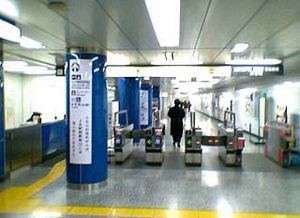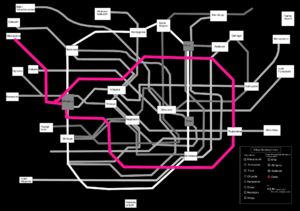Toei Ōedo Line
The Toei Ōedo Line (都営地下鉄大江戸線 Toei Chikatetsu Ōedo-sen?) is a subway line in Tokyo, Japan operated by the Tokyo Metropolitan Bureau of Transportation. It commenced full operations on December 12, 2000; using the Japanese calendar this reads "12/12/12" as the year 2000 equals Heisei 12. Formerly known as Line 12, its official line color is red-violet ○.
Contents
Route information
- Length: 40.7 km
- Gauge: 1435 mm
- Stations: 38 (including ends, Tocho-mae Station counted as one station)
- Double-track: Entire line
- Electric supply: 1500 VDC
- Block system: Automatic (cab signal) (CS-ATC)
History
The first segment from Hikarigaoka to Nerima began operations on December 10, 1991 under the name Toei Line 12 (都営地下鉄12号線 Toei Chikatetsu Jūnigō-sen?). The line was extended from Nerima to Shinjuku on December 19, 1997, and later to from Shinjuku to Kokuritsu-Kyogijo on April 20, 2000. With this extension, Shintaro Ishihara, the governor of Tokyo, named the line Toei Ōedo Line, where Ōedo literally means "Great Edo", a reference to Tokyo's former name. The full line began operation on December 12, 2000. An additional station (Shiodome Station) was opened on November 2, 2002 to connect to the Yurikamome guideway transit line.
The Ōedo Line is Tokyo's first linear motor metro line, which allows it to use smaller cars and smaller tunnels. These putative cost savings were, however, offset by the need to build the line very deep (as low as 48 meters below ground at points) through central Tokyo, including three underground crossings of the Sumida River. Originally budgeted at ¥682.6 million and 6 years, the construction ended up taking nearly 10 years and estimates of the final cost of construction range from the official ¥988.6 billion to over ¥1,400 billion yen, making it the most expensive subway line ever built.[1] (Yokohama's Minato Mirai Line, however, was even costlier if measured per kilometer.)
Ridership projections originally estimated 1 million users daily, a figure scaled down to 820,000 before opening. However, at the end of 2005, five years after opening, the line was only averaging 680,000 passengers/day, and at the current rate of growth the figure is unlikely to exceed 700,000 even in 2015.[1] The line is thus unlikely to recoup its costs in 35 years as expected.
Future developments
There are plans to extend the Oedo Line westward from its current western terminus at Hikarigaoka Station through Ōizumi-gakuen Station (on the Seibu Ikebukuro Line) to Higashi-Tokorozawa Station (on the Musashino Line). Construction of the first segment to Ōizumi-gakuen is tentatively scheduled for before 2015, although no concrete planning has yet been implemented.
Operation
The Ōedo Line runs in a loop around central Tokyo before branching out towards Nerima in the western suburbs, meaning the line is shaped like a figure of 6 lying on its side. It is not a true loop line: trains from the western Hikarigaoka terminus run anticlockwise around the loop and terminate at the intermediate Tochō-mae Station facing towards Hikarigaoka, and vice-versa.
The terminals and major stations include Hikarigaoka, Roppongi, Daimon, Ryogoku, Iidabashi, and Tocho-mae. Stations on the Toei Ōedo Line carry the letter E followed by a number.
Stations
Note: the stations are listed following the clockwise route starting from Tocho-mae station
Gallery
Roppongi Station, E-23
References
- ↑ 1.0 1.1 都営12号線(大江戸線)環状部事業の評価(総括表), Toei
Mass transit in Tokyo | |
|---|---|
| Metro lines (Subway) | Chiyoda · Fukutoshin · Ginza · Hanzōmon · Hibiya · Marunouchi · Namboku · Tōzai · Yūrakuchō |
| Toei lines | Subway: Asakusa · Mita · Ōedo · Shinjuku Streetcar: Arakawa |
| JR lines | Yamanote · Chūō · Chūō-Sōbu · Jōban · Keihin-Tōhoku · Keiyō · Saikyō · Shōnan-Shinjuku · Sōbu · Tōkaidō · Yokosuka |
| Other networks | Keikyū · Keiō · Keisei · Nippori-Toneri · Odakyū · Seibu · Tōbu · Tokyo Monorail · Tōkyū · TWR · TX · Yurikamome |
| Around Tokyo | Chiba Monorail · Enoden · Hokusō · Saitama Rapid · Saitama New Urban · Shin-Keisei · Shōnan Monorail · Sōtetsu · Tama Monorail · Tōyō Rapid · Yokohama MM · Yokohama Subway |
| Terminals | Asakusa · Ikebukuro · Kita-Senju · Oshiage · Shibuya · Shinagawa · Shinjuku · Tōkyō · Ueno |
| Miscellaneous | PASMO · Passnet · Suica · Transportation in Greater Tokyo |
fr:Toei Ōedo ko:도쿄 도 교통국 지하철 12호선 오에도 선 ja:都営地下鉄大江戸線 zh:都營大江戶線






